Carlsbad CA—The Carlsbad City Council voted this week to continue providing lifeguard services along the beach from Oak Avenue to the city’s northern border. Unlike the majority of Carlsbad’s nearly seven miles of coastline, this area of the beach in Carlsbad is not park of the California State Parks system and therefore has limited services.
At a Glance
- The City of Carlsbad Fire Department will provide lifeguards during the peak beach-going season in 2018.
- City staff will solicit bids from other public agencies that provide lifeguard service.
- By Oct. 31, city staff will return to the City Council with the results of the bid solicitation and the extended pilot program run by Fire Department personnel.
- The City Council will decide how best to provide lifeguard service moving forward.
More Information
In recent years, the number of people using this part of the beach has increased, prompting safety concerns. The City of Carlsbad police and fire departments respond to emergency calls in this area but do not patrol the beach like lifeguards would.
The City Council directed staff last April to conduct a pilot program from Memorial Day weekend through Labor Day 2017. Based on the results of that program, the City Council decided to continue to provide the service.
Among the factors the City Council will consider when deciding how to provide lifeguard service after this summer are the level of service that would be provided and the overall cost of that service. Coastal cities provide lifeguard service in a variety of ways. For example, in North County, the cities of Oceanside, Solana Beach and Del Mar have city lifeguards that patrol city controlled beaches. Encinitas provides city lifeguards through a contract with the state since the state controls the beaches in Encinitas. The state provides lifeguard services on the beaches it controls in Carlsbad.
City staff estimate that it will cost between $350,000 to $550,000 a year to provide lifeguard service on North Beach, although those estimates could change based on bids received from other agencies. City staff will gather data on the amount of money that could be generated by running programs, such as junior lifeguards, on the beach, which could help offset the cost of the lifeguard service. City still will also analyze the cost savings achieved by preventing and responding to beach emergencies that otherwise would result in a 9-1-1 call.
The Fire Department will seek input from neighbors and beach users on possible locations for towers, although towers will not go up this year. Once locations are chosen, the proposed placement and design would need to undergo a state permitting process.
The beach from Oak Avenue to the northern city limit is not part of the California State Parks system, which includes Carlsbad State Beach from around Pine Avenue South to Terramar and South Carlsbad State Beach from the state campground to the southern city limit. State lifeguards patrol these areas. In the north, property owners own the beach directly in front of their properties out to what is called the “mean high tide line,” which is generally where the water meets the sand during high tide.
The City of Carlsbad maintains public easements on this property, which allow people to utilize the beach and the city to provide services.
During annual goal setting sessions the past few years, the Carlsbad City Council has made beach improvements one of its top priorities. City staff is working on a number of projects along the city’s nearly seven miles of coastline, including sprucing up the seven public beach entrances along Ocean Street and making them more visible.
The city has already completed projects to widen bike lanes along Carlsbad Boulevard, improve the accessibility of the Ocean Street public parking lot, put new drought proof landscaping along the beach bluff north of Tamarack to prevent erosion and installed crosswalks with flashing lights to make it safer to cross Carlsbad Boulevard.
Longer term projects include redesigning portions of Carlsbad Boulevard to ease traffic flow, make more room for walking and biking, and maximize access to the coast.



